Liquid Lens Modules Market Size
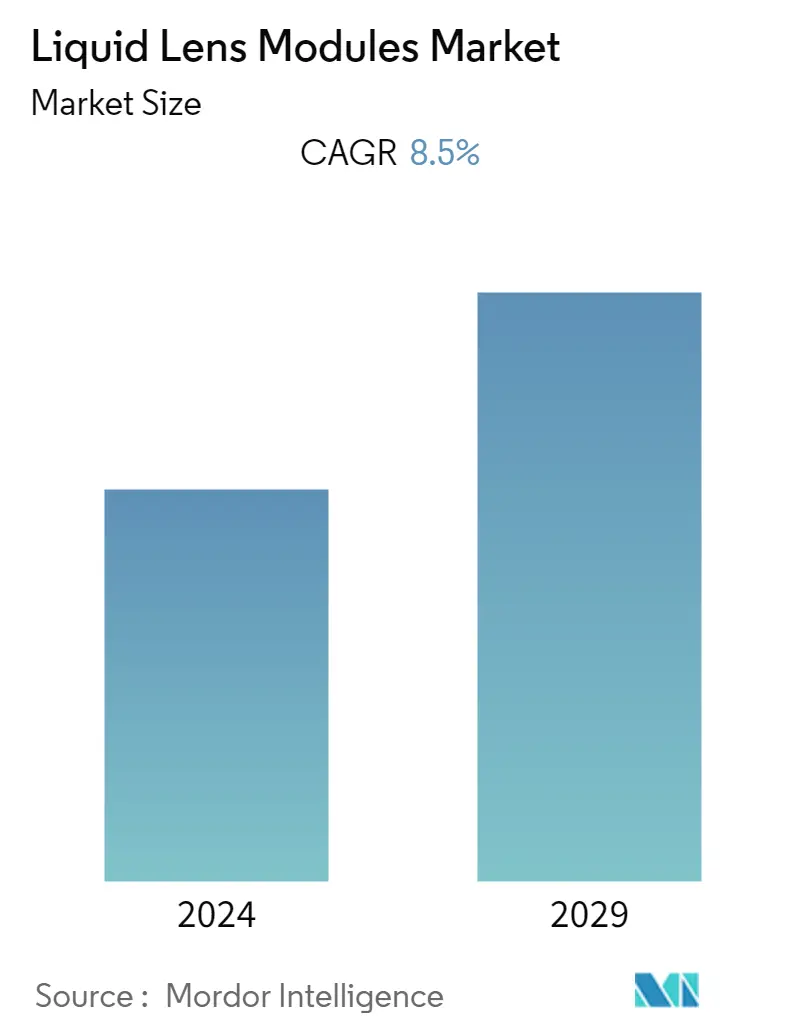
| Study Period | 2019 - 2029 |
| Base Year For Estimation | 2023 |
| CAGR | 8.50 % |
| Fastest Growing Market | Asia Pacific |
| Largest Market | North America |
| Market Concentration | Medium |
Major Players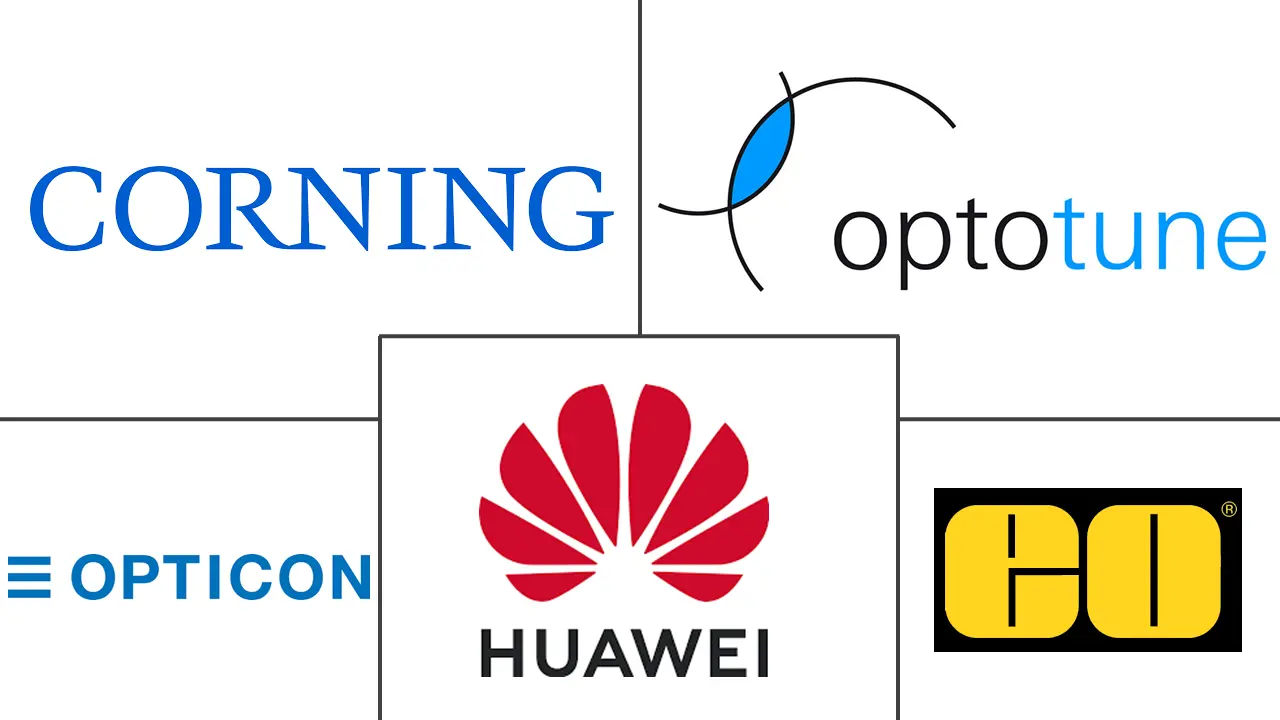
*Disclaimer: Major Players sorted in no particular order |
Need a report that reflects how COVID-19 has impacted this market and its growth?
Liquid Lens Modules Market Analysis
The liquid lens module market was valued at USD 157.6 million during the current year and is anticipated to reach USD 237.3 million by the end of the forecast period, registering a CAGR of 8.5% during the forecast period. Liquid lenses' speed, adaptability, and versatility make them suitable for several machine vision, life science, and measuring and inspection applications. When combined with a distance sensor and camera, a liquid lens may instantly image different planes of a 3D object. The photos are then stitched together in software to create an accurate three-dimensional depiction.
- Liquid lenses swiftly focus on accommodating objects at various WDs (working distances). Liquid lenses are small, mechanically, or electrically controlled cells comprising optical-grade liquid. The cell's shape changes when a current or voltage is applied to a liquid lens cell. This change happens within milliseconds and generates the optical power, and therefore focal length and WD, to shift. Several manufacturers have designed liquid lenses that operate through slightly different processes: electrowetting, current-driven polymer, or sound piezoelectric. Liquid lenses are suitable solutions for imaging applications requiring rapid focusing, high throughput, depth of field (DOF), and WD accommodation.
- Liquid lenses can be implemented in several locations throughout an imaging system, like being embedded within or threaded to the front or rear of an imaging lens. Fixed Focal Length and Zoom lenses usually rely on mechanical or manual adjustments to change focus, that can slow the imaging system. Liquid lens camera modules have very fast response times. A liquid lens eliminates mechanics, allowing for a more compact construction. Further, the functionality of liquid lenses is equivalent to that of several discrete lenses within an assembly. The total size and weight of the entire lens are reduced by eliminating those lenses and replacing them with a tiny liquid cell.
- The liquid lens modules are also useful for requiring rapid automated inspection like barcode reading, package sorting, and quality control. Another application where these small, variable-focus lenses are helpful is in AR applications/VR devices that need compact, lightweight, fast & low power consuming, silent lenses for zooming and focusing.
- Moreover, the rapid variable focus of a liquid lens can adjust dynamically as an airborne unit travels at various heights above the ground or distances from objects. They're especially useful in applications like geographic information/mapping systems, agricultural inspection & monitoring, and surveillance.
- However, liquid lens camera modules are a complex system involving a myriad of disciplines, technologies, and processes. The supply chain is witnessing complexities against the backdrop of overlaps between the activities of the modules' sub-component manufacturing companies. Challenges in realizing robust liquid lens module technology further add to the complexity of the ecosystem of the market, thereby creating challenges for the evolution of the technology. The high manufacturing costs are also anticipated to restrain the growth of the studied market during the forecast period.
- The COVID-19 pandemic increased the demand for contactless and minimally invasive forms of identification, which led to advancements in liquid lens technology for iris recognition. Liquid lens-enabled iris recognition systems offer an accurate and hygienic form of biometric identification, as they do not require physical contact between the user and the scanner. Additionally, liquid lenses possess a fast response time, as low as 10ms, enabling auto-focus and continuous focus for biometric applications. Outside of biometrics, liquid lenses also have the potential for applications in biomedical detection and micro-optic systems.
Liquid Lens Modules Market Trends
The Camera Segment is Expected to Drive the Market's Growth
- A liquid lens camera is a type of camera that uses a liquid lens in place of a traditional, static optical glass lens. Liquid lenses are comprised of a small cell containing an optical-grade liquid that changes shape when a current or voltage is applied. This change in shape produces an autofocus effect, allowing the camera to adjust focus quickly and accurately. One of the main advantages of liquid lens cameras is that they provide superior image quality and auto-focus functionality compared to traditional fixed-focus lenses. They also have the ability to change focal length without any moving parts, making them more durable and reliable.
- Tunable lens technology has the potential to transform the way smartphones achieve zoom. Smartphone cameras typically simulate zoom by utilizing numerous modules, each optimized for a particular focusing distance. The information acquired by these modules is then combined with image-processing algorithms to produce a sharp photograph. Tunable lenses would allow a single camera module to adjust its focusing distance, achieving real optical zoom while reducing the number of modules required.
- To that end, in April 2021, Xiaomi collaborated with OFILM and NEXTLENS to develop the first smartphone tunable lens. Optotune's offshoot, NEXTLENS, specializes in tunable optics for scientific purposes. A transparent fluid is encased in a malleable membrane that may be sculpted by a voice coil motor system to form the liquid lens module. The liquid lens camera module can focus between 3 cm and 8 cm by operating in tandem with traditional fixed lenses. It may thus reach a 2.7x optical zoom and double as a macro and telephoto camera module, all while costing less than conventional telephoto modules featured in Samsung and Apple flagships.
- The introduction of advanced camera technologies coupled with the increasing global demand for smartphones is expected to boost the growth of the studied market. For instance, according to Ericsson, the number of smartphone subscriptions worldwide amounted to over 6,259 million in 2021 and is expected to reach 7,690 million in 2027.
- Moreover, according to GSMA, in North America, the number of smartphone subscribers is anticipated to reach 328 million by the year 2025. Moreover, by 2025, the region may witness an increase in the penetration rates of mobile subscribers (86%) and the Internet (80%). Additionally, according to GSMA, by 2025, Europe is expected to register the highest internet penetration rate (82%) and smartphones (88%). Such a huge rise in smartphones would create an opportunity for the liquid lens modules incorporated in smartphone cameras to cater to a wide range of needs of customers.
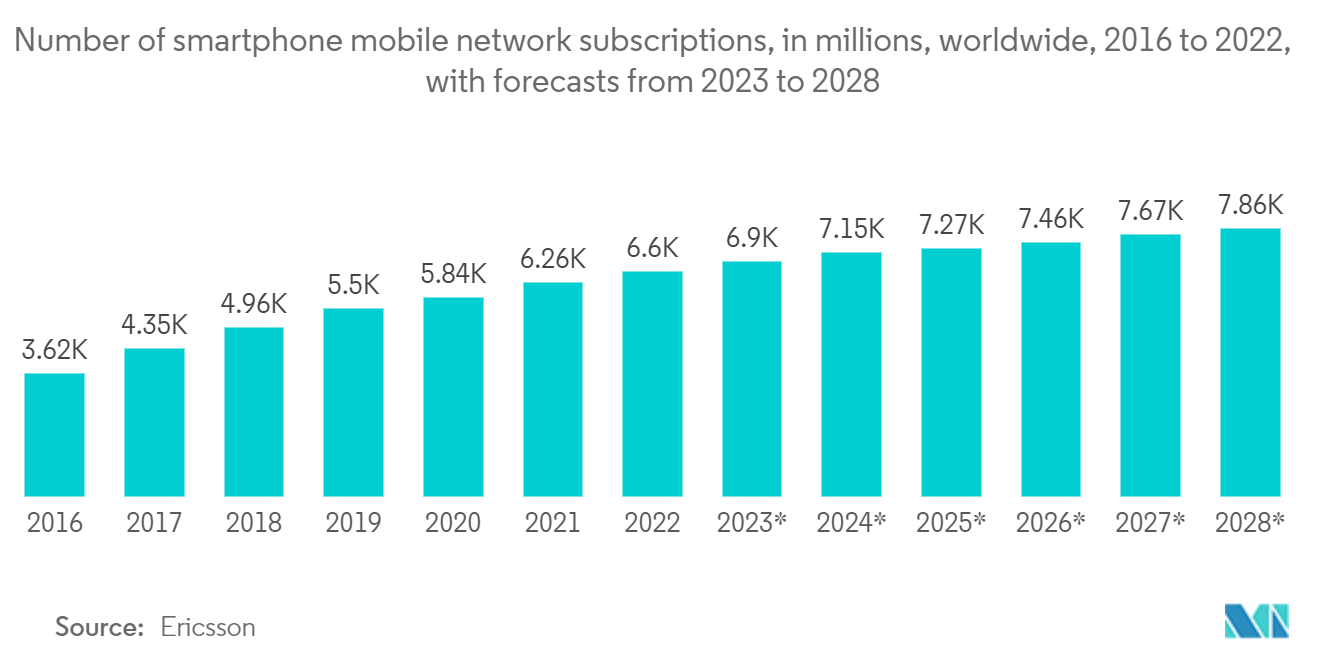
North America is Expected to Hold a Major Market Share
- North America is expected to hold a significant share of the studied market. Liquid lenses have a wide range of applications in various fields, such as machine vision, medical equipment, and more. Liquid lenses are used in machine vision systems to provide autofocus capabilities and improve image quality. Companies like Cognex, which is based in Massachusetts, offer machine vision systems that incorporate liquid lenses.
- The region is witnessing several advancements in the studied market. For instance, NASA has been developing and experimenting with liquid lenses for space exploration, including building giant space telescopes. Liquid lenses are filled with fluid that can adjust their focal length by electrowetting. They are seen as an enabler of very large optical space telescopes as they are much cheaper to construct than conventional glass mirrors. In April 2022, NASA reported that they would conduct the Fluidic Telescope Experiment (FLUTE) in the ISS, which would test liquid lenses by using water injected by polymers in microgravity through utilizing buoyancy to even gravitational forces and cause weightlessness, to be later hardened by UV light or temperature in-orbit. NASA has also tested adjustable liquid-lens eyeglasses for use in space. This would drive the demand for the liquid lens module market.
- Further, one of Canada's most notable liquid lens experiments is the Large Zenith Telescope, which used a rotating liquid-metal mirror made of mercury with a diameter of 6 meters and rotated at a rate of about 8.5 revolutions per minute. It was decommissioned due to unsuitable weather conditions at its testing site. However, plans for larger liquid-mirror telescopes, such as the ALPACA and LAMA projects, have been proposed for astronomical use. Liquid lenses have also been used in other experimental setups in Canada, such as the Fluidic Telescope Experiment (FLUTE), which investigates using liquids to construct telescope lenses. Other experimental studies have focused on liquid-liquid-vapor systems, measuring the line tension of three-phase interfaces and simulations for liquid lens setups.
- There are several references to liquid lenses and their development in Florida, particularly at the University of Central Florida's College of Optics and Photonics. Some notable developments include liquid lenses with electro-optical focus and tilt control, variable-focus liquid lenses, and adaptive dielectric liquid lenses.
- The region also has many market players who provide efficient products to cater to a wide range of needs of consumers. For instance, Baumer USA and ITALA G.EL offer industrial GigE vision cameras with liquid lens control. Cognex mentions that their barcode readers use liquid lens technology to automatically adapt to different focus distances. Lomography offers a camera called HydroChrome Sutton's Panoramic Belair Camera that has a liquid-filled lens. The presence of numerous competitors in the region is likely to boost the growth of the studied market.
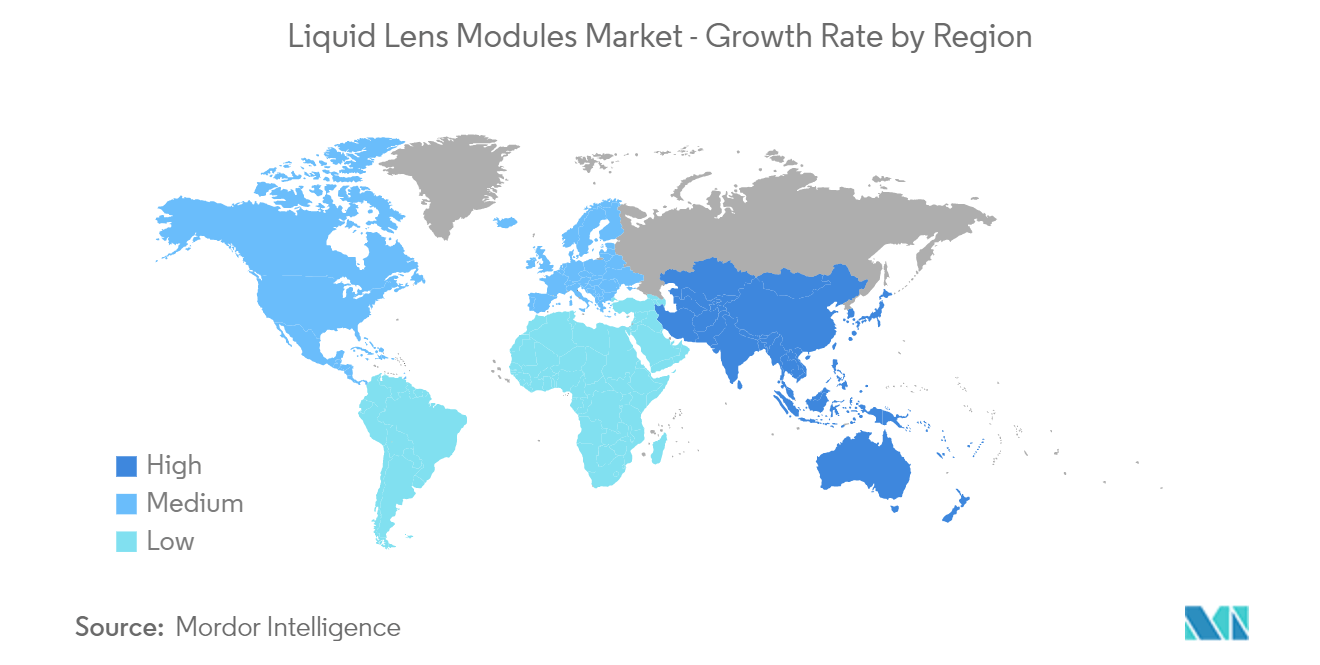
Liquid Lens Modules Industry Overview
The liquid lens module market is moderately consolidated with the presence of a few major companies like Corning Incorporated, Xiaomi, etc. The companies continuously invest in strategic partnerships and product developments to gain more market share. Some of the recent developments in the market are:
In July 2022, Morrow, a Belgian high-tech start-up produced auto focal glasses that allow users to switch between near and distance vision at the push of a button. The advanced liquid crystal technology is embedded between two ultra-precise, thin-cut optical lenses and may be triggered by adding a small dose of electrical power, which directs the liquid crystal to refract light in a certain manner.
In May 2022, Xiaomi announced that it would include a second-generation liquid-lens camera in its forthcoming flagship smartphone. The first-generation Xiaomi foldable was also the first-generation Xiaomi liquid lens camera smartphone. This breakthrough technology enabled a single Mix Fold sensor to handle both zoom and macro pictures. Now, its significantly upgraded replacement could be set to launch in a future high-end smartphone.
Liquid Lens Modules Market Leaders
Corning Incorporated
Huawei Technologies Co., Ltd.
Optotune
Opticon
Edmund Optics
*Disclaimer: Major Players sorted in no particular order
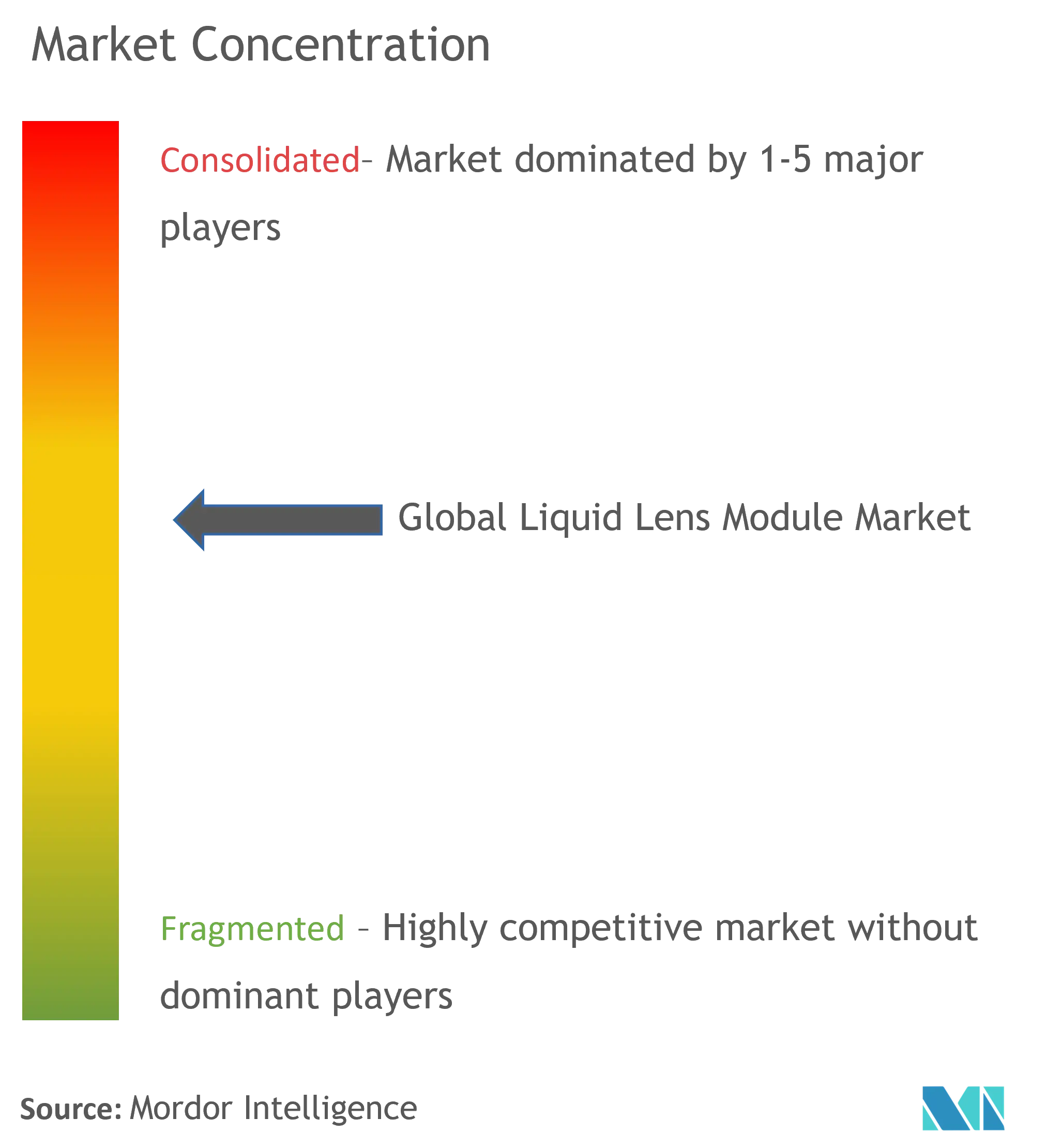
Liquid Lens Modules Market News
- October 2022: OptoEngineering introduced itsTCZEL telecentric zoom lens, which combines two liquid lenses at the same time. This permits the optics' magnification and operating distance to be precisely adjusted without the need of moving parts.
- September 2022: Sill Optics created a 2x magnifying telecentric lens with a big aperture and an integrated liquid lens for adjusting the focus. The realization of a high aperture for a 2.74m pixel size, a 1.1'' sensor diagonal, and reliable imaging performance for varied wavelengths has significantly boosted the demand for magnifying telecentric lenses. It has been difficult to add a focus tunable liquid lens while preserving imaging performance. Still, Sill Optics and Optotunehave achieved 90 lp/mm resolution throughout the full FOV using an EL16-40 with the best wavefront specification in vertical alignment.
Table of Contents
1. INTRODUCTION
1.1 Study Assumptions and Market Definition
1.2 Scope of the Study
2. RESEARCH METHODOLOGY
3. EXECUTIVE SUMMARY
4. MARKET INSIGHTS
4.1 Market Overview
4.2 Industry Attractiveness - Porter's Five Forces Analysis
4.2.1 Bargaining Power of Suppliers
4.2.2 Bargaining Power of Buyers
4.2.3 Threat of New Entrants
4.2.4 Intensity of Competitive Rivalry
4.2.5 Threat of Substitutes
4.3 Technology Snapshot
4.4 Value Chain Analysis
4.5 Assessment of Impact of COVID-19 on the Market
5. MARKET DYNAMICS
5.1 Market Drivers
5.1.1 Rising demand for high performance and energy efficient lenses
5.1.2 Rising popularity of photography and increasing demand for pro-HD cameras
5.2 Market Restrains
5.2.1 High manufacturing costs
6. MARKET SEGMENTATION
6.1 By Component
6.1.1 Image Sensor
6.1.2 Lens
6.1.3 Camera Module Assembly
6.1.4 VCM Suppliers
6.2 By Application
6.2.1 Camera
6.2.2 Code Reader
6.2.3 Medical Imaging
6.3 By Geography
6.3.1 North America
6.3.2 Europe
6.3.3 Asia-Pacific
6.3.4 Rest of the World
7. COMPETITIVE LANDSCAPE
7.1 Company Profiles
7.1.1 Corning Incorporated
7.1.2 Huawei Technologies Co., Ltd.
7.1.3 Optotune
7.1.4 Opticon
7.1.5 Edmund Optics
7.1.6 Varioptic
- *List Not Exhaustive
8. INVESTMENT ANALYSIS
9. FUTURE OUTLOOK OF THE MARKET
Liquid Lens Modules Industry Segmentation
A liquid lens is a camera technology that substitutes a static optical glass lens. It employs optical-grade liquid in the center of a cell structure and functions similarly to an eye lens. A liquid lens permits the lens to alter its form by means of adjusting the liquid inside it, which enhances focusing speed and focal length.
The Liquid lens modules market is segmented by component (Image sensor, Lens, Camera module Assembly, VCM), application (Camera, Code Reader, Medical Imaging), and geography (North America, Europe, Asia-Pacific, and the Rest of the World). The market sizes and forecasts are provided in terms of value (USD million) for all the above segments.
| By Component | |
| Image Sensor | |
| Lens | |
| Camera Module Assembly | |
| VCM Suppliers |
| By Application | |
| Camera | |
| Code Reader | |
| Medical Imaging |
| By Geography | |
| North America | |
| Europe | |
| Asia-Pacific | |
| Rest of the World |
Frequently Asked Questions
What is the current Liquid Lens Modules Market size?
The Liquid Lens Modules Market is projected to register a CAGR of 8.5% during the forecast period (2024-2029)
Who are the key players in Liquid Lens Modules Market?
Corning Incorporated , Huawei Technologies Co., Ltd., Optotune, Opticon and Edmund Optics are the major companies operating in the Liquid Lens Modules Market.
Which is the fastest growing region in Liquid Lens Modules Market?
Asia Pacific is estimated to grow at the highest CAGR over the forecast period (2024-2029).
Which region has the biggest share in Liquid Lens Modules Market?
In 2024, the North America accounts for the largest market share in Liquid Lens Modules Market.
What years does this Liquid Lens Modules Market cover?
The report covers the Liquid Lens Modules Market historical market size for years: 2019, 2020, 2021, 2022 and 2023. The report also forecasts the Liquid Lens Modules Market size for years: 2024, 2025, 2026, 2027, 2028 and 2029.
Liquid Lens Modules Industry Report
Statistics for the 2024 Liquid Lens Modules market share, size and revenue growth rate, created by Mordor Intelligence™ Industry Reports. Liquid Lens Modules analysis includes a market forecast outlook to for 2024 to 2029 and historical overview. Get a sample of this industry analysis as a free report PDF download.
